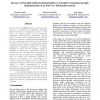396 search results - page 7 / 80 » How scientific models can explain |
INFOCOM
2010
IEEE
13 years 6 months ago
2010
IEEE
—In this paper, we develop an analytical framework which explains the emergence of superpeer networks on execution of the commercial peer-to-peer bootstrapping protocols by incom...
COLING
1990
13 years 8 months ago
1990
One of the issues of Artificial Intelligence is the transfer of the knowledge conveyed by Natural Language into formalisms that a computer can interpret. In the Natural Language P...
HICSS
2003
IEEE
14 years 23 days ago
2003
IEEE
Qureshi, et al. (2002) [1] presented a case study where they used a framework, the Intellectual Bandwidth Model to measure an organization’s ability to create value. The model c...
ELPUB
2006
ACM
2006
ACM
Weaving the Web of Science. HyperJournal and the Impact of the Semantic Web on Scientific Publishing
14 years 1 months ago
In this paper we present HyperJournal, an Open Source web application for publishing on-line Open Access scholarly journals. In the first part (sections 1-3) we briefly describe t...
SYNTHESE
2010
13 years 2 months ago
2010
Most scientific models are not physical objects, and this raises important questions. What sort of entity are models, what is truth in a model, and how do we learn about models? In...

